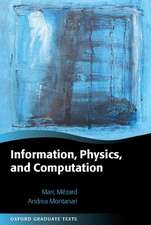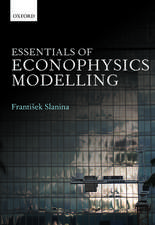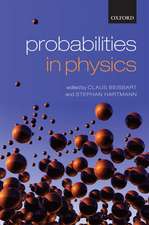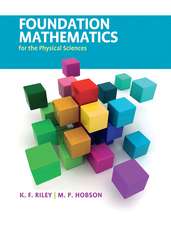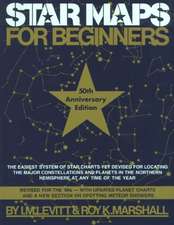Theoretical Physics on the Personal Computer
Autor Erich W. Schmid Traducere de A. H. Armstrong Autor Gerhard Spitz, Wolfgang Löschen Limba Engleză Paperback – 12 dec 2011
Supplementary electronic material no longer available.
Preț: 447.93 lei
Preț vechi: 553.00 lei
-19% Nou
Puncte Express: 672
Preț estimativ în valută:
85.71€ • 89.90$ • 71.35£
85.71€ • 89.90$ • 71.35£
Carte tipărită la comandă
Livrare economică 28 martie-03 aprilie
Preluare comenzi: 021 569.72.76
Specificații
ISBN-13: 9783642754739
ISBN-10: 3642754732
Pagini: 232
Dimensiuni: 170 x 242 x 12 mm
Greutate: 0.4 kg
Ediția:2nd ed. 1990. Softcover reprint of the original 2nd ed. 1990
Editura: Springer
Colecția Springer
Locul publicării:Berlin, Heidelberg, Germany
ISBN-10: 3642754732
Pagini: 232
Dimensiuni: 170 x 242 x 12 mm
Greutate: 0.4 kg
Ediția:2nd ed. 1990. Softcover reprint of the original 2nd ed. 1990
Editura: Springer
Colecția Springer
Locul publicării:Berlin, Heidelberg, Germany
Public țintă
Lower undergraduateDescriere
This book is based on the lecture course "Computer applications in Theo retical Physics", which has been offered at the University of Tiibingen since 1979. This course had as its original aim the preparation of students for a nu merical diploma course in theoretical physics. It soon became clear, however, that the course provides a valuable supplement to the fundamental lectures in theoretical physics. Whereas teaching in this field had previously been prin cipally characterised by the derivation of equations, it is now possible to give deeper understanding by means of application examples. A graphical presen tation of numerical results proves to be important in emphasizing the physics. Interaction with the machine is also valuable. At the end of each calculation the computer should ask the question: "Repeat the calculation with new data (yes/no )?". The student can then answer "yes" and input the new data, e.g. new starting values for position and velocity in solving an equation of motion. The programming of a user-friendly dialogue is not really difficult, but time consuming. At the beginning of the course the student therefore constructs only the numerical parts of the programs. The numerical parts are therefore deleted from the programs under consideration, and newly programmed by the student. Later on, the programming of the graphical output and of the dialogue is taught.
Cuprins
1. Introduction.- 1.1 Programming of the Numerical Portions of the Programs.- 1.2 Programming of the Input and Output.- 2. Numerical Differentiation and Introduction into Screen Dialogue.- 2.1 Formulation of the Problem.- 2.2 Mathematical Methods.- 2.3 Programming.- 2.4 Exercises.- 2.5 Solutions to the Exercises.- 3. Numerical Integration.- 3.1 Formulation of the Problem.- 3.2 Numerical Methods.- 3.2.1 The Trapezoidal Rule.- 3.2.2 The Simpson Rule.- 3.2.3 Newton-Cotes Integration.- 3.2.4 The Gauss-Legendre Integration.- 3.3 Programming.- 3.4 Exercises.- 3.5 Solutions to the Exercises.- 4. Harmonic Oscillations with Sliding and Static Friction, Graphical Output of Curves.- 4.1 Formulation of the Problem.- 4.2 Numerical Treatment.- 4.2.1 Transformation of the Differential Equation.- 4.2.2 The Euler Method.- 4.3 Programming.- 4.4 Exercises.- 4.5 Solutions to the Exercises.- 5. Anharmonic Free and Forced Oscillations.- 5.1 Formulation of the Problem.- 5.2 Numerical Treatment.- 5.2.1 Improvement of the Euler Method.- 5.2.2 The Runge-Kutta Method.- 5.3 Programming.- 5.4 Exercises.- 5.5 Solutions to the Exercises.- 6. Coupled Harmonic Oscillations.- 6.1 Formulation of the Problem.- 6.2 Numerical Method.- 6.3 Programming.- 6.4 Exercises.- 6.5 Solutions to the Exercises.- 7. The Flight Path of a Space Craft as a Solution of the Hamilton Equations.- 7.1 Formulation of the Problem.- 7.2 Mathematical Methods.- 7.2.1 Mesh Width Adaptation in the Runge-Kutta Method.- 7.2.2 Coordinate Transformation.- 7.3 Programming.- 7.3.1 Hamilton’s Equations of Motion.- 7.3.2 Automatic Mesh Width Adjustment in the Runge-Kutta Method.- 7.3.3 Coordinate Transformation.- 7.3.4 Main Program.- 7.4 Exercises.- 7.5 Solutions to the Exercises.- 8. The Celestial Mechanics Three-body Problem.- 8.1 Formulation of the Problem.- 8.2 Mathematical Method.- 8.3 Programming.- 8.4 Exercises.- 8.5 Solutions to the Exercises.- 9. Computation of Electric Fields by the Method of Successive Over-relaxation.- 9.1 Formulation of the Problem.- 9.2 Numerical Method.- 9.2.1 Discretisation of Laplace’s Equation.- 9.2.2 The Method of Successive Over-relaxation.- 9.3 Programming.- 9.4 Exercises.- 9.5 Solutions to the Exercises.- 10. The Van der Waals Equation.- 10.1 Formulation of the Problem.- 10.2 Numerical Method.- 10.3 Programming.- 10.4 Exercises.- 10.5 Solutions to the Exercises.- 11. Solution of the Fourier Heat Conduction Equation and the “Geo-Power Station”.- 11.1 Formulation of the Problem.- 11.2 Method of Solution.- 11.3 Programming.- 11.4 Exercises.- 11.5 Solutions to the Exercises.- 12. Group and Phase Velocity in the Example of Water Waves.- 12.1 Formulation of the Problem.- 12.2 Numerical Method.- 12.3 Programming.- 12.4 Exercises.- 12.5 Solutions to the Exercises.- 13. Solution of the Radial Schrödinger Equation by the Fox-Goodwin Method.- 13.1 Formulation of the Problem.- 13.2 Numerical Method of Solution.- 13.3 Programming.- 13.4 Exercises.- 13.5 Solutions to the Exercises.- 14. The Quantum Mechanical Harmonic Oscillator.- 14.1 Formulation of the Problem.- 14.2 Numerical Method.- 14.3 Programming.- 14.4 Exercises.- 14.5 Solutions to the Exercises.- 15. Solution of the Schrödinger Equation in Harmonic Oscillator Representation.- 15.1 Formulation of the Problem.- 15.2 Numerical Method.- 15.3 Programming.- 15.4 Exercises.- 15.5 Solutions to the Exercises.- 16. The Ground State of the Helium Atom by the Hylleraas Method.- 16.1 Formulation of the Problem.- 16.2 Setting up the State Basis and the Matrix Equation.- 16.3 Programming.- 16.4 Exercises.- 16.5 Solutions to the Exercises.- 17. The Spherical Harmonics.- 17.1 Formulation of the Problem.- 17.2 Numerical Method.- 17.3 Programming.- 17.4 Exercises.- 17.5 Solutions to the Exercises.- 18. The Spherical Bessel Functions.- 18.1 Formulation of the Problem.- 18.2 Mathematical Method.- 18.3 Programming.- 18.4 Exercises.- 18.5 Solutions to the Exercises.- 19. Scattering of an Uncharged Particle from a Spherically Symmetric Potential.- 19.1 Formulation of the Problem.- 19.2 Mathematical Treatment of the Scattering Problem.- 19.3 Programming.- 19.4 Exercises.- 19.5 Solutions to the Exercises.- References.

